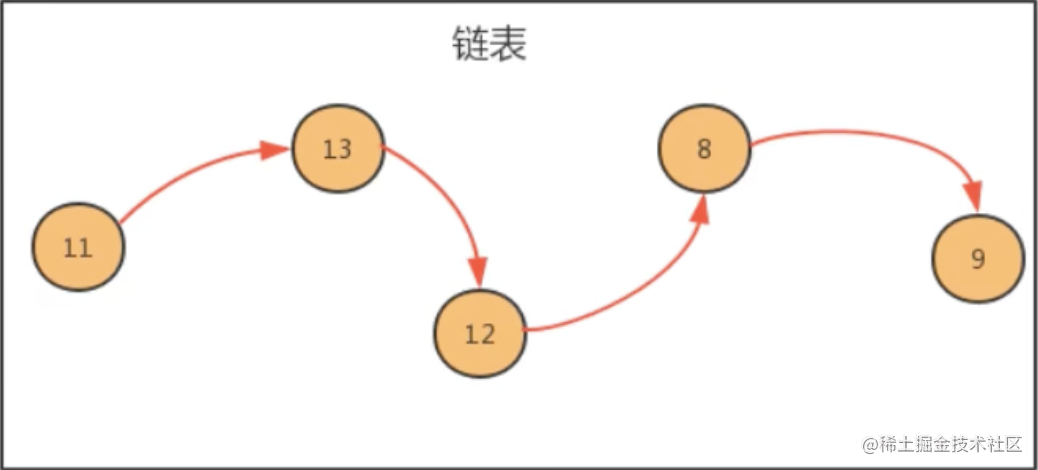前言 之前我们介绍了使用顺序存储结构实现顺序表,我们发现虽然顺序表的查询很快,时间复杂度为 O(1),但是增删的效率是比较低的,因为每一次增删操作都伴随着大量的数据元素移动。这个问题有没有解决方案呢?
答:有,我们可以使用另外一种存储结构实现线性表:链式存储结构。
一、链表介绍 链表是一种物理存储单元上非连续,非顺序的存储结构,其物理结构不能直观的表示数据元素的逻辑顺序,数据元素的逻辑顺序是通过链表中的指针链接次序实现的。链表由一系列的节点(链表中的每一个元素称为节点)组成,节点可以运行时动态生成,如下图演示:
那我们如何使用链表呢?按照面向对象的思想,我们可以设计一个类,来描述节点这个事物,用一个属性描述这个节点存储的元素,用另外一个属性描述这个节点的下一个节点。
节点 API 设计:
类名
Node<T>
构造方法
Node(T t,Node next) :创建 Node 对象
成员变量
T item :存储数据
具体实现:
1 2 3 4 5 6 7 8 9 10 11 12 13 14 15 16 17 18 19 20 21 22 23 24 25 26 27 28 29 30 public class Node <T>{public T item;public Node next;public Node (T item,Node next) {this .item = item;this .next = next;public class Test {public static void main (String[] args) {new Node <>(11 , null );new Node <>(13 , null );new Node <>(12 , null );new Node <>(8 , null );new Node <>(9 , null );
链表主要分为两种:
1、单向链表
2、双向链表
二、单向链表 单向链表是链表的一种,它由多个节点组成,每个节点都由一个数据域和一个指针域组成,数据域用来存储数据,指针域用来指向其后继节点。链表的头节点的数据域不存储数据,指针域指向第一个真正存储数据的节点。
1.1、单向链表 API 设计
类名
LinkList<T>
构造方法
LinkList() :创建 LinkList 对象
成员方法
1、public void clean() :清空线性表
成员内部类
private class Node<T> :节点类
成员变量
1、private Node head :记录头节点
具体实现:
1 2 3 4 5 6 7 8 9 10 11 12 13 14 15 16 17 18 19 20 21 22 23 24 25 26 27 28 29 30 31 32 33 34 35 36 37 38 39 40 41 42 43 44 45 46 47 48 49 50 51 52 53 54 55 56 57 58 59 60 61 62 63 64 65 66 67 68 69 70 71 72 73 74 75 76 77 78 79 80 81 82 83 84 85 86 87 88 89 90 91 92 93 94 95 96 97 98 99 100 101 102 103 104 105 106 107 public class LinkList <T> {private Node head;private int N;private class Node {private T item;private Node next;public Node (T item, Node next) {this .item = item;this .next = next;public LinkList () {new Node (null , null );this .N = 0 ;public void clear () {null ;this .N = 0 ;public boolean isEmpty () {return this .N == 0 ;public int length () {return N;public T get (int i) {Node node = head.next;if (node == null ) return null ;for (int i1 = 0 ; i1 < i; i1++) {if (node == null ) return null ;return node.item;public void insert (T t) {Node node = head;while (node.next != null ){new Node (t,null );public void insert (int index,T t) {Node pre = head;for (int i = 0 ; i <= index - 1 ; i++) {Node current = pre.next;Node newNode = new Node (t, current);public T remove (int index) {Node pre = head;for (int i = 0 ; i <= index - 1 ; i++) {Node current = pre.next;return current.item;public int indexOf (T t) {int index = 0 ;Node node = head.next;while (node != null ){if (node.item.equals(t)){return index;return -1 ;
1.2、单向链表遍历 在 Java 中,遍历集合的方式一般都是用 foreach 循环,如果想让我们的 SequenceList 也能支持 foreach ,则需要做如下操作:
1、让 LinkList 实现 Iterable 接口,重写 iterator 接口
2、在 LinkList 内部提供一个内部类 LIterator,实现 Iterator 接口,重写 hasNext() 方法和 next() 方法
具体实现如下:
1 2 3 4 5 6 7 8 9 10 11 12 13 14 15 16 17 18 19 20 21 22 23 24 25 26 27 28 29 30 31 32 33 34 35 36 37 38 39 40 41 42 43 44 45 46 47 48 49 50 51 52 53 54 55 56 57 58 59 60 61 62 63 64 65 66 67 68 69 70 71 72 73 74 75 76 77 78 79 80 81 82 83 84 85 86 87 88 89 90 91 92 93 94 95 96 97 98 99 100 101 102 103 104 105 106 107 108 109 110 111 112 113 114 115 116 117 118 119 120 121 122 123 124 125 126 127 128 129 130 131 132 133 134 135 class LinkList <T> implements Iterable <T>{private Node head;private int N;private class Node {private T item;private Node next;public Node (T item, Node next) {this .item = item;this .next = next;public LinkList () {new Node (null , null );this .N = 0 ;public void clear () {null ;this .N = 0 ;public boolean isEmpty () {return this .N == 0 ;public int length () {return N;public T get (int i) {Node node = head.next;if (node == null ) return null ;for (int i1 = 0 ; i1 < i; i1++) {if (node == null ) return null ;return node.item;public void insert (T t) {Node node = head;while (node.next != null ){new Node (t,null );public void insert (int index,T t) {Node pre = head;for (int i = 0 ; i <= index - 1 ; i++) {Node current = pre.next;Node newNode = new Node (t, current);public T remove (int index) {Node pre = head;for (int i = 0 ; i <= index - 1 ; i++) {Node current = pre.next;return current.item;public int indexOf (T t) {int index = 0 ;Node node = head.next;while (node != null ){if (node.item.equals(t)){return index;return -1 ;@NonNull @Override public Iterator<T> iterator () {return new LIterator ();private class LIterator implements Iterator <T>{private Node curr;public LIterator () {@Override public boolean hasNext () {return curr.next != null ;@Override public T next () {return curr.item;
1.3、单向链表测试 1 2 3 4 5 6 7 8 9 10 11 12 13 14 15 16 17 18 19 20 21 22 23 24 25 26 27 28 public class Test {public static void main (String[] args) {new LinkList <>();"姚明" );"科比" );"麦迪" );1 ,"詹姆斯" );for (String s : strList) {String result = strList.get(1 );String removeElement = strList.remove(0 );
三、单向链表时间复杂度分析 3.1、get(i) 方法时间复杂度 get(i) 每一次查询,都要从链表的头开始,依次向后查询,随着数据元素 N 的增加,比较的元素也越多,时间复杂度为 O(n)
3.2、insert(int i,T t) 方法时间复杂度 insert(int i,T t) 每一次插入,需要先找到 i 位置的前一个元素,然后完成插入操作,随着数据元素 N 的增多,查找的元素越多,时间复杂度为 O(n)
3.3、remove(int i) 方法时间复杂度 remove(int i) 每一次删除,需要先找到 i 位置的前一个元素,然后完成移除操作,随着数据元素 N 的增多,查找的元素越多,时间复杂度为 O(n)
相比较顺序表:
1、链表插入和删除时间复杂度虽然一样,但仍然有很大的优势,因为链表的物理地址是不连续的,它不需要预先指定存储空间大小,或者存储过程中涉及扩容等操作,同时它并没有涉及元素的交换。
2、链表的查询操作性能会比较低,因此如果我们的程序中查询操作比较多,建议使用顺序表,增删操作比较多,建议使用链表。
四、总结 本篇文章我们介绍了:
1、链表的节点及具体实现
2、单向链表的 API 设计,到具体实现,到添加增强 for 循环遍历,到用例测试
3、单向链表的时间复杂度分析:
1、get(i) :O(n)
2、insert(int i,T t) :O(n)
3、remove(int i) :O(n)
虽然链表的插入和删除的时间复杂度和顺序表一样,但是它不需要预先指定存储空间以及扩容等操作,效率还是很高的,因此涉及到增删比较多的情况使用链表,查询比较多的则使用顺序表
好了,本篇文章到这里就结束了,感谢你的阅读🤝



